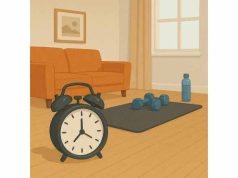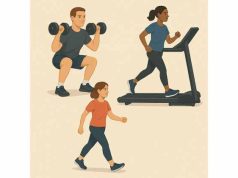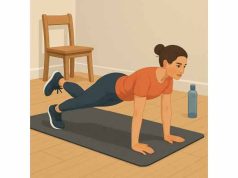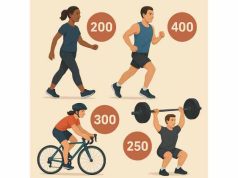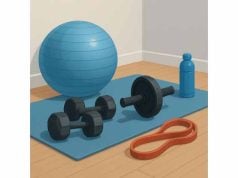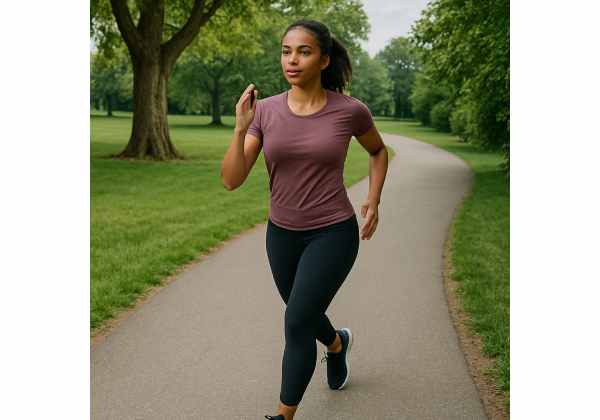
Walking is one of the simplest ways to create a calorie deficit without wrecking your joints or schedule. The “10,000 steps a day” idea is not magic, but it’s a practical target that nudges you to sit less, move more, and pair activity with reasonable nutrition. In this guide you’ll learn what 10,000 steps actually does for fat loss, how fast to walk, how long it takes, how to scale your plan, and what results to expect. If you’re also considering strength and cardio alongside walking, see our overview of exercise options for weight loss to build a balanced routine.
Table of Contents
- Does 10,000 steps help weight loss?
- Best walking pace for fat loss
- Time, calories, and results
- Build your 10,000-steps plan
- Progressions and cross-training
- Plateaus, injuries, troubleshooting
- Who should adjust or avoid
- Frequently Asked Questions
Does 10,000 steps help weight loss?
“10,000 steps” is a behavior target, not a medical prescription. Its power comes from consistency and total movement across your day. Fat loss happens when your average weekly energy intake is lower than your average weekly energy expenditure. Walking contributes to that expenditure in a sustainable way, while preserving the energy you need for work, family, and training.
Here is what 10,000 steps changes:
- Time on feet and daily energy burn. Walking more increases non-exercise activity (NEAT), which often drops during dieting. Keeping NEAT higher helps you avoid the “I’m dieting, so I barely move” trap.
- Appetite signals. Moderate walking tends to be appetite-neutral or mildly appetite-taming for many people compared with higher-intensity exercise that can spike hunger. Your mileage will vary, so notice how walking affects your eating.
- Recovery and stress. Easy walking promotes blood flow and parasympathetic tone. It complements—rather than competes with—strength training and harder cardio, which is useful while in a calorie deficit.
- Adherence. You can do it anywhere, in any weather with minor adjustments (treadmill, mall, stairs). The best plan is the one you’ll repeatedly follow.
What it does not do on its own:
- Guarantee a specific weekly weight-loss number.
- Replace resistance training (critical for muscle retention).
- Justify overeating “because I hit my steps.”
Expected outcomes. For most adults, 10,000 steps is roughly 4–5 miles (6.5–8 km), depending on stride length, and commonly takes 75–110 minutes of total walking at an easy to moderate pace across the day. The energy cost varies widely by body size, terrain, pace, and incline. Many people find that getting to 8,000–12,000 daily steps (averaged over a week) meaningfully supports a gentle fat-loss rate when paired with steady nutrition.
Who benefits most. Beginners, people with sedentary jobs, and anyone returning from a layoff often see quick wins—better sleep, lower resting heart rate, more stable energy. If your schedule is packed, steps spread across the day (commuting, breaks, errands) may feel easier than carving out long gym blocks.
How 10,000 fits into a complete plan. Use steps to raise your baseline movement, add two or three brief strength sessions to keep muscle, and match your food intake to your goals. If you’re new to the nutrition side, our overview of healthy weight-loss basics will help you set realistic expectations.
Bottom line: 10,000 steps is a clear, actionable goal that helps most people move enough to support weight loss—provided nutrition and sleep cooperate. Think of it as the foundation, not the entire house.
Best walking pace for fat loss
You don’t need a punishing speed to lose fat. The sweet spot for most walkers is easy-to-moderate intensity—roughly the pace where you can speak in full sentences but feel you’re working (a perceived effort of 4–6 out of 10). In heart-rate terms, that’s often about 60–70% of your age-predicted max, sometimes called “Zone 2.” This is sustainable, low-stress work that you’ll repeat day after day.
Why pace matters:
At very easy paces, you’ll still burn energy, but you may need more minutes to reach your target steps. At very brisk paces, you burn more per minute, but the session feels harder and might reduce how much you move later in the day. The right balance is the pace you’ll keep—and recover from—daily.
How to find your pace without tech:
- Start at a comfortable walk for 5 minutes.
- Gradually increase speed until conversation becomes slightly effortful, not breathless.
- Stay there for most of the session.
- Sprinkle 30–90-second brisk segments if you enjoy them, returning to easy pace between.
With a heart-rate monitor: Aim to keep most walking in the 60–70% HRmax band. If you like structured aerobic work, learn more about Zone 2 cardio and apply those concepts to your walks.
Terrain and incline: Flat routes keep intensity consistent. Hills and treadmills at 3–6% incline raise your training load at a given speed. Use incline sparingly if you’re prone to calf or Achilles tightness; build up over weeks.
Cadence cue: Many walkers feel “purposeful but smooth” around 110–125 steps per minute. You don’t need to count constantly—use it to check in occasionally.
Red flags to slow down: Persistent shin pain, low-back tightness, numb toes, or breathlessness that prevents full sentences. Reduce pace, shorten stride, or move to flatter ground, then re-build.
Takeaway: Choose the easiest pace that keeps you engaged, then let volume (more minutes or steps) do most of the fat-loss work.
Time, calories, and results
How long does 10,000 steps take? For most people, 10,000 steps takes about 75–110 minutes spread across the day. That range tightens as your stride and pace become consistent. Short legs, crowded sidewalks, and hilly routes push you toward the high end; long strides and steady terrain pull you lower.
What about calories burned? Calorie burn varies with body mass, speed, grade, and efficiency. A small adult at an easy pace might burn a little over 200–300 calories during 10,000 steps; a larger adult at a brisk pace might burn 400–600+. Treat any number from a watch or treadmill as an estimate, not a permission slip to eat more.
Turning steps into results:
- Weekly averaging beats daily perfection. Aim for a weekly average of 70,000 steps (10k/day) but don’t panic if life happens. A 12k day can balance a 7k day.
- Pair movement with food awareness. Even modest deficits—roughly 300–500 calories per day—add up to gradual, sustainable fat loss. Steps make that deficit easier without leaving you drained.
- Keep protein and strength training in the mix. Protein supports fullness and muscle; brief lifting sessions preserve lean mass, which helps maintain your daily energy burn.
- Sleep matters. Short sleep increases appetite and reduces non-exercise movement. Protect 7–9 hours when you can.
A practical way to judge progress:
- Track scale weight 3–4 mornings per week and take the weekly average (less noise).
- Measure waist or clothing fit every 2–3 weeks.
- Watch performance signs: an easier time hitting 10k, steadier energy, better mood.
If you like numbers, compare your estimates with our overview of calories burned while walking—then come back to the basics: move more, eat just a bit less than maintenance, and be consistent.
Expectation setting: A steady plan often yields around 0.25–0.75 kg (0.5–1.5 lb) per week for many adults, with normal ups and downs from water and glycogen. Faster loss is not always better; preserving muscle and sanity is the priority.
Build your 10,000-steps plan
1) Choose your pattern. Decide whether you’re a “accumulation” walker (steps throughout the day) or a “session” walker (one or two purposeful walks). Both work. Many people do one 30–45-minute walk plus smaller bites: stairs, parking farther away, short calls while walking.
2) Schedule anchors. Pick two or three non-negotiable slots tied to existing habits—after coffee, during lunch, after dinner. Anchors reduce decision fatigue.
3) Set ranges, not absolutes. Use a daily floor/target/ceiling like 7k / 10k / 13k steps. On high-stress days, hit the floor; on calm days, chase the ceiling. Weekly averages tend to land right where you need them.
4) Use cues to move.
- Place your shoes by the door.
- Pair short walks with repetitive tasks (podcasts, phone catch-ups).
- Put a water bottle away from your desk so you must get up.
5) Track lightly. A pedometer, phone, or watch is fine. Review weekly averages; avoid obsessing over single days.
6) Fuel your day. Base meals around lean protein, colorful plants, and slow-digesting carbs, with enough fluids and a pinch of salt if you sweat. If you routinely sit long hours, add simple NEAT strategies between walks to keep your daily burn up.
7) Build guardrails.
- Have a rainy-day or heat-wave plan (indoor routes, mall laps, treadmill).
- Create a “minimum viable walk” (10 minutes) to protect momentum on chaotic days.
- Ask a friend or family member to join a weekly walk for accountability.
8) Review monthly. If progress stalls, adjust one variable at a time—nutritional intake, step target, or training mix—so you can see what worked.
Sample week:
Mon–Fri: 30–45-minute purposeful walk + two 10–15-minute breaks (aim 9–11k).
Sat: Longer scenic walk (12–15k).
Sun: Recovery day strolls (7–9k) or errands on foot.
Progressions and cross-training
Once 10,000 steps feels routine, progression keeps results coming without overuse aches.
Progress slowly, then specifically:
- Volume first. Nudge your weekly average by 5–10% for 2–3 weeks (e.g., 70k → 74–77k).
- Terrain next. Add gentle hills or a 3–6% treadmill incline to 1–2 sessions per week.
- Pace last. Introduce 4–8 short brisk repeats (30–90 seconds) with easy walking between.
Pair walking with strength. Two or three 20–35-minute sessions per week (squats or sit-to-stands, hinges/hip thrusts, pushes, pulls, loaded carries) preserve muscle, support posture, and make long walks feel easier.
Optional interval ideas (2x/week max):
- Rolling surges: During a 30-minute walk, alternate 2 minutes brisk, 3 minutes easy x 6.
- Hill repeats: On a gentle incline, 6–10 repeats of 45 seconds strong, walk down easy.
Cross-training to reduce boredom and stress on joints:
- Cycling or rowing for low-impact conditioning.
- Swimming or elliptical on days your feet need a break.
- Yoga or mobility to maintain stride mechanics.
If you’re a treadmill regular, our incline walking guide shows how to combine grade, speed, and intervals without overloading your calves or low back.
Signs you progressed too fast: Sore shins, tight calves, achy hips, or a sudden drop in daily energy. Back off for a week, keep easy walking, and resume with smaller jumps.
Key principle: Make one change at a time—volume, terrain, or pace. Let your body adapt before layering the next challenge.
Plateaus, injuries, troubleshooting
When the scale stalls: First, verify behaviors. Check your weekly step average, food consistency, sleep, and stress. If those are solid for two weeks and weight is flat, lower average intake slightly (100–200 calories/day) or raise average steps (by 1–2k/day), not both at once.
“I walk more, but I’m hungrier.” Spread protein across meals, include fiber-rich carbs and produce, and plan a satisfying snack after longer walks. Fluids and a little sodium can help if you sweat heavily.
Shin splints or sore feet: Progress volume more gradually, shorten stride, avoid sudden hills, and rotate footwear. Consider softer surfaces for some sessions. If pain persists or affects your gait, consult a clinician.
Knee or hip discomfort: Strengthen quads, glutes, and calves; keep cadence brisk with shorter steps; vary routes to avoid repetitive stress. Swap one or two walks for cycling or pool work until symptoms calm.
Weather barriers:
- Heat: Go earlier or later, use shaded routes, slow the pace, and hydrate.
- Cold: Layer properly, warm up indoors, and shorten first sessions outside.
- Rain/snow: Use treadmill, indoor tracks, or mall walking.
Busy-day fallback: Three 10–15-minute brisk walks still add up. Stairs, parking further out, and walking meetings keep your streak alive.
Recovery practices: Gentle mobility before walking, easy calf and hip stretches after, and occasional self-massage. If you stack hard days, add a lighter day next. Explore our overview of warm-up and recovery for walk-friendly routines.
Mindset reset: Progress is not linear. Use monthly averages, not single weigh-ins, to judge success. Keep “minimum viable walk” days in your plan so momentum never drops to zero.
Who should adjust or avoid
Walking is safe for most people, but context matters.
Adjust your target if:
- You’re very sedentary or returning after illness/injury. Start with a weekly average of 4–6k steps/day, add 500–1,000 steps every few days, and build to 8–10k over weeks.
- You have significant joint pain, peripheral neuropathy, or balance issues. Favor flat routes, supportive shoes, and shorter but more frequent walks.
- You’re in a heavy training block for another sport. Keep most walking easy and flexible to avoid accumulating too much fatigue.
Special populations:
- Pregnancy: Many can continue walking comfortably. Use talk-test intensity, avoid overheating, and seek personalized guidance from your clinician.
- Older adults: Prioritize safety, posture, and cadence. Add light strength and balance work to prevent falls.
- Higher body mass: Choose supportive footwear and softer surfaces; introduce incline gradually; consider water walking or stationary cycling on alternate days to reduce foot stress.
Medical conditions: If you live with cardiovascular, metabolic, or orthopedic conditions—or take medications affecting heart rate or balance—ask your healthcare provider for parameters. Use effort-based cues, not just heart-rate formulas, since some drugs change heart-rate response.
When to stop and check: Chest pain, unusual shortness of breath, dizziness, or sharp joint pain are stop-signals. Seek medical care if symptoms persist.
Remember: The goal is sustainable daily movement. If 10,000 steps is too much right now, choose a number you can repeat most days and build from there.
Frequently Asked Questions
How many calories does 10,000 steps burn?
Estimates vary by body size, pace, and terrain. Roughly, smaller adults may expend 200–300 calories across 10,000 steps, while larger adults at a brisk pace might burn 400–600+. Treat watch or treadmill numbers as approximations and focus on weekly trends and consistent habits.
Is 10,000 steps enough to lose weight without dieting?
Some people lose weight by increasing steps alone, especially if they were very sedentary. Most achieve steadier results by pairing steps with modest nutrition changes—slightly smaller portions, more protein and produce, and fewer calorie-dense extras—to create a reliable weekly deficit.
What pace should I aim for when walking for fat loss?
Aim for an easy-to-moderate pace: you can talk in full sentences but feel you’re working. That’s typically around 60–70% of age-predicted max heart rate. If you don’t track heart rate, use the talk test and a steady, purposeful stride you can maintain daily.
How long does it take to walk 10,000 steps?
Most adults need 75–110 minutes in total, depending on stride length, pace, terrain, and interruptions. Shorter legs, crowded routes, and hills push you toward the higher end; longer strides and steady, flat routes shorten the time required.
Are 10,000 steps safe during pregnancy or for older adults?
Often, yes—if intensity is comfortable and you have no contraindications. Use the talk test, avoid overheating, and listen to symptoms. Older adults benefit from supportive shoes, flat routes, and added balance/strength work. Always follow your clinician’s guidance for your situation.
What if I can’t reach 10,000 steps every day?
Use weekly averages. Set a realistic floor (e.g., 6–8k) and a target (10k) with a stretch day. Three 10–15-minute walks can cover most of your steps on busy days. Consistency over months matters more than perfect daily numbers.
References
- A Meta-Analysis of Pedometer-Based Walking Interventions and Weight Loss – PMC 2008 (Systematic Review)
- Walking cadence (steps/min) and intensity in 41 to 60-year-old adults: the CADENCE-adults study | International Journal of Behavioral Nutrition and Physical Activity | Full Text 2020
- Measuring Physical Activity Intensity | Physical Activity | CDC 2022
- WHO guidelines on physical activity and sedentary behaviour 2020 (Guideline)
- Physical Activity and Exercise During Pregnancy and the Postpartum Period | ACOG 2020 (Guideline)
Medical Disclaimer
This article provides general information and is not a substitute for personalized medical advice. Always consult your healthcare professional before starting or changing an exercise, nutrition, or weight-loss program, especially if you have medical conditions, are pregnant, or take prescription medications.
If you found this helpful, please share it with a friend. You’re welcome to follow us on Facebook or X for more practical guides and training plans.


